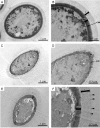Silver nanoparticle production by the fungus Fusarium oxysporum: nanoparticle characterisation and analysis of antifungal activity against pathogenic yeasts
- PMID: 24714966
- PMCID: PMC4015259
- DOI: 10.1590/0074-0276130269
Silver nanoparticle production by the fungus Fusarium oxysporum: nanoparticle characterisation and analysis of antifungal activity against pathogenic yeasts
Abstract
The microbial synthesis of nanoparticles is a green chemistry approach that combines nanotechnology and microbial biotechnology. The aim of this study was to obtain silver nanoparticles (SNPs) using aqueous extract from the filamentous fungus Fusarium oxysporum as an alternative to chemical procedures and to evaluate its antifungal activity. SNPs production increased in a concentration-dependent way up to 1 mM silver nitrate until 30 days of reaction. Monodispersed and spherical SNPs were predominantly produced. After 60 days, it was possible to observe degenerated SNPs with in additional needle morphology. The SNPs showed a high antifungal activity against Candida and Cryptococcus , with minimum inhibitory concentration values ≤ 1.68 µg/mL for both genera. Morphological alterations of Cryptococcus neoformans treated with SNPs were observed such as disruption of the cell wall and cytoplasmic membrane and lost of the cytoplasm content. This work revealed that SNPs can be easily produced by F. oxysporum aqueous extracts and may be a feasible, low-cost, environmentally friendly method for generating stable and uniformly sized SNPs. Finally, we have demonstrated that these SNPs are active against pathogenic fungi, such as Candida and Cryptococcus.
Figures





Similar articles
-
Fusarium as a Novel Fungus for the Synthesis of Nanoparticles: Mechanism and Applications.J Fungi (Basel). 2021 Feb 15;7(2):139. doi: 10.3390/jof7020139. J Fungi (Basel). 2021. PMID: 33672011 Free PMC article. Review.
-
Biosynthesized silver and gold nanoparticles are potent antimycotics against opportunistic pathogenic yeasts and dermatophytes.Int J Nanomedicine. 2018 Feb 1;13:695-703. doi: 10.2147/IJN.S152010. eCollection 2018. Int J Nanomedicine. 2018. PMID: 29440895 Free PMC article.
-
Characterization of silver nanoparticles produced by biosynthesis mediated by Fusarium oxysporum under different processing conditions.Bioprocess Biosyst Eng. 2017 Sep;40(9):1291-1303. doi: 10.1007/s00449-017-1788-9. Epub 2017 May 24. Bioprocess Biosyst Eng. 2017. PMID: 28540439
-
Biosynthesis of silver nanoparticles by the fungus Arthroderma fulvum and its antifungal activity against genera of Candida, Aspergillus and Fusarium.Int J Nanomedicine. 2016 May 4;11:1899-906. doi: 10.2147/IJN.S98339. eCollection 2016. Int J Nanomedicine. 2016. PMID: 27217752 Free PMC article.
-
Bright Side of Fusarium oxysporum: Secondary Metabolites Bioactivities and Industrial Relevance in Biotechnology and Nanotechnology.J Fungi (Basel). 2021 Nov 8;7(11):943. doi: 10.3390/jof7110943. J Fungi (Basel). 2021. PMID: 34829230 Free PMC article. Review.
Cited by
-
Fusarium as a Novel Fungus for the Synthesis of Nanoparticles: Mechanism and Applications.J Fungi (Basel). 2021 Feb 15;7(2):139. doi: 10.3390/jof7020139. J Fungi (Basel). 2021. PMID: 33672011 Free PMC article. Review.
-
Antifungal Effects of Silver Phytonanoparticles from Yucca shilerifera Against Strawberry Soil-Borne Pathogens: Fusarium solani and Macrophomina phaseolina.Mycobiology. 2018 Mar 29;46(1):47-51. doi: 10.1080/12298093.2018.1454011. eCollection 2018. Mycobiology. 2018. PMID: 29998032 Free PMC article.
-
Analyzing formation of silver nanoparticles from the filamentous fungus Fusarium oxysporum and their antimicrobial activity.Turk J Biol. 2018 Feb 15;42(1):54-62. doi: 10.3906/biy-1710-2. eCollection 2018. Turk J Biol. 2018. PMID: 30814870 Free PMC article.
-
Green Synthesis of Antileishmanial and Antifungal Silver Nanoparticles Using Corn Cob Xylan as a Reducing and Stabilizing Agent.Biomolecules. 2020 Aug 25;10(9):1235. doi: 10.3390/biom10091235. Biomolecules. 2020. PMID: 32854282 Free PMC article.
-
Multi-functional nano silver: A novel disruptive and theranostic agent for pathogenic organisms in real-time.Sci Rep. 2016 Sep 26;6:34058. doi: 10.1038/srep34058. Sci Rep. 2016. PMID: 27666290 Free PMC article.
References
-
- Ahamed M, AlSalhi MS, Siddiqui MKJ. Silver nanoparticle applications and human health. Clin Chim Acta. 2010;411:1841–1848. - PubMed
-
- Ahmad A, Mukherjee P, Senapati S, Mandal D, Khan MI, Kumar R, Sastry M. Extracellular biosynthesis of silver nanoparticles using the fungus Fusarium oxysporum . Colloids Surf. 2003;B 28:313–318.
-
- Akaighe N, MacCuspie RI, Navarro DA, Aga DS, Banerjee S, Sohn M, Sharma VK. Humic acid-induced silver nanoparticle formation under environmentally relevant conditions. Environ Sci Technol. 2011;45:3895–3901. - PubMed
-
- Burgess LW. PE Nelson, TA Toussoun, RJ Cook. Fusarium: diseases, biology and taxonomy. Pennsylvania State University Press; Philadelphia: 1981. General ecology of the fusaria; pp. 225–235.
-
- Chaloupka K, Malam Y, Seifalian AM. Nanosilver as a new generation of nanoproduct in biomedical applications. Trends Biotechnol. 2010;28:580–588. - PubMed
Publication types
MeSH terms
Substances
LinkOut - more resources
Full Text Sources
Other Literature Sources

